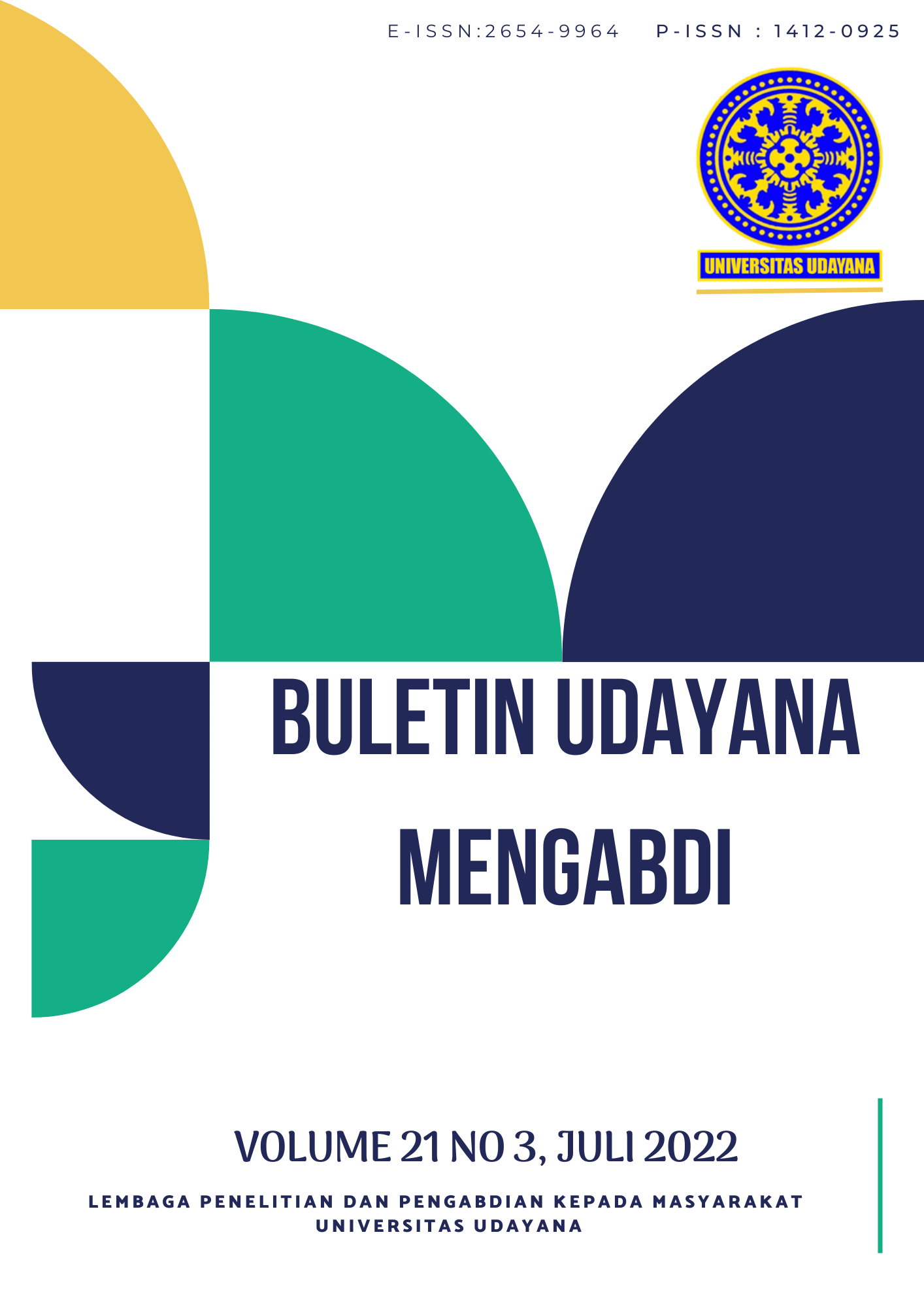LAYANAN TELE-HEALTH KOMUNIKASI INFORMASI EDUKASI (T-health-KIE) BAGI PASIEN COVID-19 RUANG ISOLASI SEBUAH RUMAH SAKIT SWASTA DI BALI
Abstract
The atmosphere of treatment in the isolation room is scary for Covid-19 patients, especially at the beginning of the pandemic, plus there is "stigma" in the community and the patient must be alone without any family who dares to accompany during hospitalization. All of these conditions make a heavy burden on the patient's psyche. The community service activities are provided mainly using WhatsApp media, as a telehealth service of communication information and education (namely T-health-KIE). The service was conducted from May to September in the year 2021, aimed to provide psychological support and offer correct information about the patient's illness, as well as other relevant information. Patients are also given a package containing snacks and toiletries/body care products as patients’ needs during treatment in the isolation room. The package given is received directly by the patient or the patient's family representative at the hospital. The T-health-KIE has conducted among 59 patients in an isolation room at a private hospital in Bali, consisting of 33 male and 26 female patients, with an age range of 19 to 78 years old. Fortunately, is that there has been a decreased anxiety of patients who threatened in isolation rooms in the 2nd year of the pandemic compared to the previous year (at the beginning of the Covid-19 pandemic). The T-health-KIE service is an innovative and safe health service for health workers during the Covid-19 pandemic. In addition to being useful for patients, it also helps to ease the burden of doctors with a heavy workload in handling Covid-19 patients.
Keywords: Covid-19, isolation,telehealth, KIE,communication information education
Downloads
References
Almathami HKY, Win KT, Vlahu-Gjorgievska E. 2020. Barriers and facilitators that influence telemedicine based, real-time, online consultation at patients’ homes: systematic literature review. J Med Internet Res;22.
Altena E, Baglioni C, Espie CA, Ellis J, Gavriloff D, Holzinger B, et al. 2020. Dealing with sleep problems during home confinement due to the COVID-19 outbreak: Practical recommendations from a task force of the European CBT-I Academy. J Sleep Res. DOI: 10.1111/jsr.13052
Barbisch D, Koenig KL, Shih FY. 2015. Is there a case for quarantine? Perspectives from SARS to Ebola. Disaster. Med Public Health Prep;9:547e53.
Brooks SK, Webster RK, Smith LE, Woodland L, Wessely S, Greenberg N, et al. 2020. The psychological impact of quarantine and how to reduce it: rapid review of the evidence. Lancet;395:912e20.
Chen S. 2020. An online solution focused brief therapy for adolescent anxiety during the novel coronavirus disease (COVID-19) pandemic: a structured summary of a study protocol for a randomised controlled trial. Trials. May 13;21(1):402. doi: 10.1186/s13063-020-04355-6.
Day Business. Panic, pandemics and the theory of Learned Helplessness. Available at: https://businessday.ng/columnist/article/panic-pandemics-and-the-theoryof-learned-helplessness/; 2020 (diunduh 1/9/2021)
Dorsey ER, Topol EJ. 2016. State of telehealth. N Engl J Med. Jul 14;375(2):154–161. doi: 10.1056/nejmra1601705
Dubey S, Biswas P, Ghosh R, Chatterjee S, Mahua Jana Dubey MJ, Chatterjee S, et al. 2020. Psychosocial impact of COVID-19. Diabetes Metab Syndr Sep-Oct;14(5):779-788. DOI: 10.1016/j.dsx.2020.05.035
Huang, Y., & Zhao, N. 2020. Generalized anxiety disorder, depressive symptoms and sleep quality during COVID-19 epidemic in China: A webbased cross-sectional survey. Psychiatry Res. Jun;288:112954. doi: 10.1016/j.psychres.2020.112954
Jeong H, Yim HW, Song YJ, Ki M, Min JA, Cho J, Chae JH. 2016. Mental health status of people isolated due to Middle East Respiratory Syndrome. Epidemiol Health. Nov 5;38:e2016048. doi: 10.4178/epih.e2016048
Kompas.Com. 2021. Data Tim Mitigasi Ikatan Dokter Indonesia (IDI). Available at: https//nasinal.kompas.com. (diunduh 1/9/2021)
Koonin LM, Hoots B, Clarisse A. Tsang CA et al. 2020. Trends in the Use of Telehealth During the Emergence of the COVID-19 Pandemic — United States, January–March 2020. Weekly. October 69(43);1595–1599
Leodoro J. Labrague RN, Janet Alexis A. de los Santos RN, 2020. Fear of COVID‐19, psychological distress, work satisfaction and turnover intention among frontline nurses. Journal of Nursing Manajemen. https://doi.org/10.1111/jonm.13168
Liu X, Kakade M, Fuller CJ, Fan B, Fang Y, Kong J, et al. 2012. Depression after exposure to stressful events: lessons learned from the severe acute respiratory syndrome epidemic. Compr Psychiatr 53:15e23
Noone C, McSharry J, Smalle M, Burns A, Dwan K, Devane D, Morrissey EC. 2020. Video calls for reducing social isolation and loneliness in older people: a rapid review. Cochrane Database Syst Rev. 2020 May 21;5:CD013632. doi: 10.1002/14651858.CD013632
Reed ME, Huang J, Graetz I, et al. 2020. Patient characteristics associated with choosing a telemedicine visit vs office visit with the same primary care clinicians. JAMA Netw Open;3.
Robertson E, Hershenfield K, Grace SL, Stewart DE. 2004. The psychosocial effects of being quarantined following exposure to SARS: a qualitative study of Toronto health care workers. Can J Psychiatr 49: 403e7.
Seminog OO & Goldacre MJ. 2013. Risk of pneumonia and pneumococcal disease in people with severe mental illness: English record linkage studies. Thorax 68:171e6.
Yao H, Chen JH, Xu YF. 2020. Patients with mental health disorders in the COVID19 epidemic. Lancet Psychiatry;7:e21

This work is licensed under a Creative Commons Attribution-ShareAlike 4.0 International License.

This work is licensed under a Creative Commons Attribution-ShareAlike 4.0 International License.




.png)


1.png) GARUDA - GARBA RUJUKAN DIGITAL
GARUDA - GARBA RUJUKAN DIGITAL



